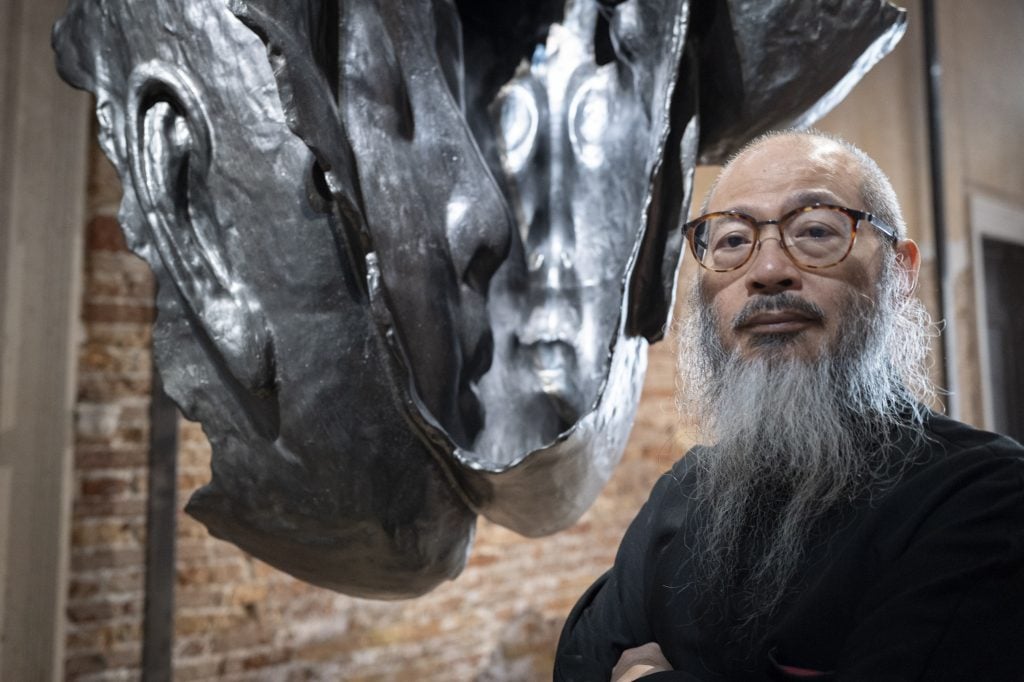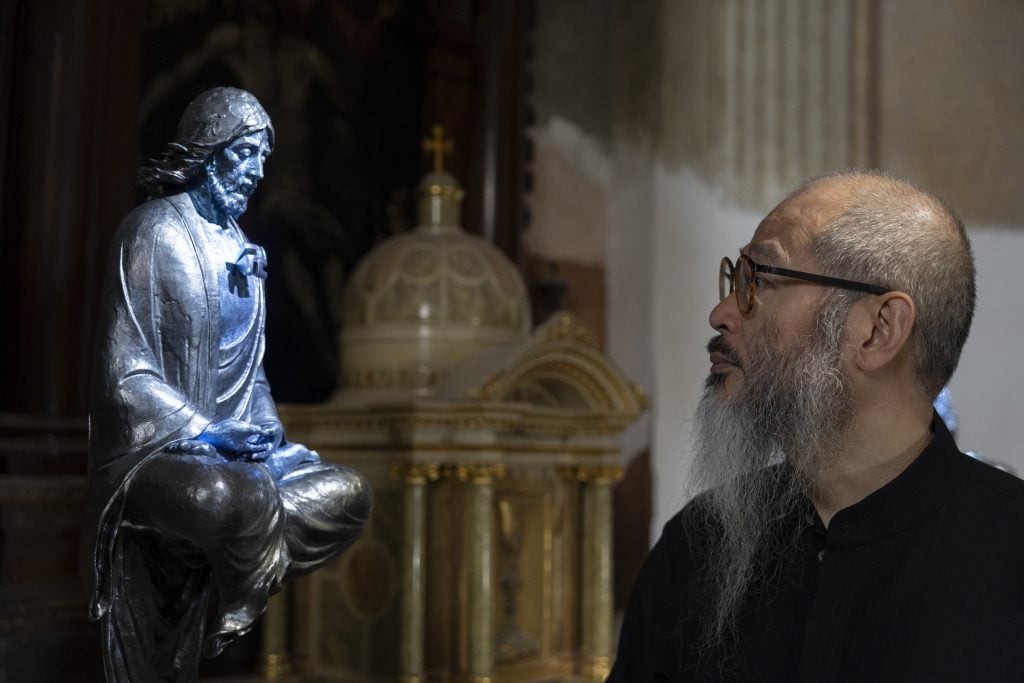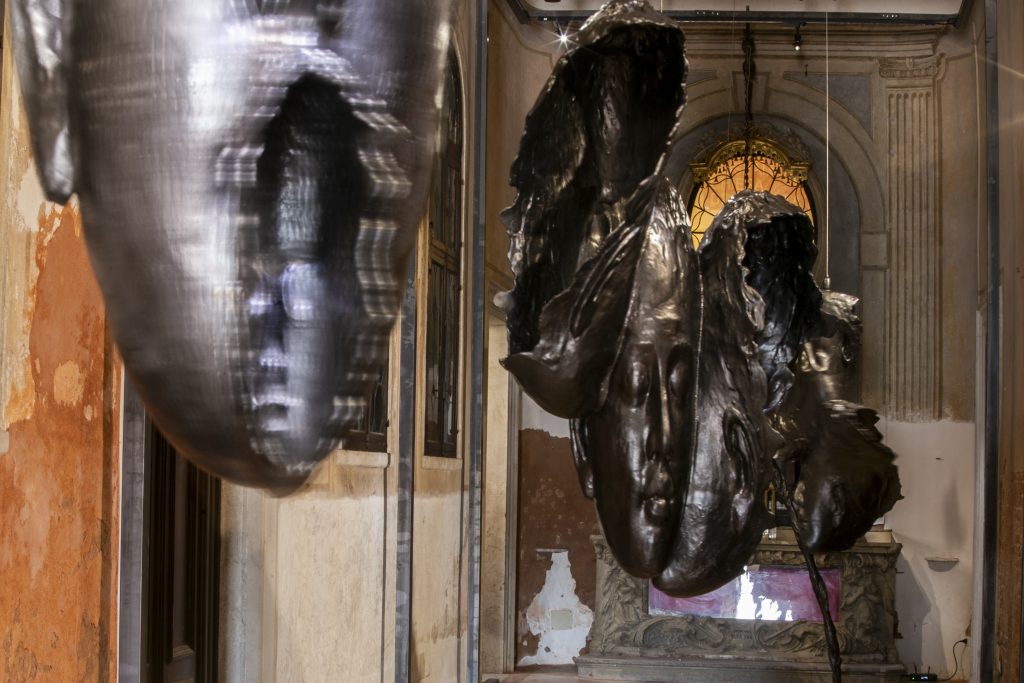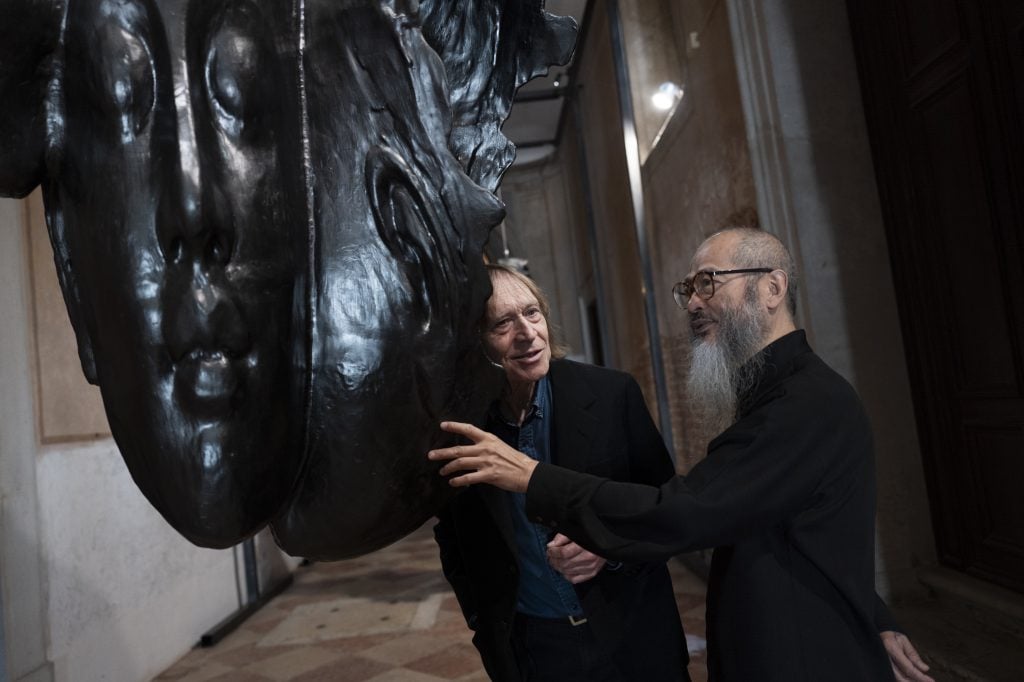Artists
Wallace Chan on Art and Alchemy
The artist explores the notion of transformation and enlightenment with a new group of titanium sculptures.

The artist explores the notion of transformation and enlightenment with a new group of titanium sculptures.

Vivienne Chow

Wallace Chan took a lemon out of the pocket of his slick, dark grey modern zhongshan suit and placed it on the table right at the entrance of Santa Maria della Pietà. It was early in the morning as the artist arrived at the venue to prepare for the opening of “Transcendence,” his third solo exhibition in Venice, coinciding with the 60th Venice Biennale. The citric fruit seemed to have little to do with the dark-colored, philosophical titanium sculptures on display. So, why did he carry a lemon with him?
“I was planning to eat it,” the artist said. Just peel it and eat it like eating an orange? “Yes.” Wouldn’t it be too sour? “No. When I had high blood sugar, I ate three lemons a day. My record was eating seven lemons in one day. Now I eat less,” Chan explained. “This is not something for everyone. My stomach can take alkaline food. If you eat a lemon with warm water at about 60 degree Celsius, it transforms from acidic to alkaline, and it is very good for my stomach. We need to be kind to our body.”

Wallace Chan posing with this titanium sculpture in his Venice exhibition ‘Transcendence’. ©Federico Sutera
Precision and attention to details are found not only in Chan’s habit of lemon consumption. These are also the principles of his artistic practice. From his creation of artisan jewelry pieces that earned him initial fame to the experimentation with the material of titanium for his large sculptures to fulfill his artistic ambitions in recent years, the essence of his practice remains unchanged.
“To me, there is no difference between making jewelry and making sculpture,” the Fuzhou-born, Hong Kong-based multidisciplinary artist said during our. He noted that when making a small piece of jewelry, the focus is placed on the fine details: the gem stones, their colors, and the synthesis of reflections.
“For example, if you have a blue gem stone, the light reflected from this stone will carry hints of purple when it is seen from a certain angle,” noted the 68-year-old. “The same goes for making large sculptures, which are about the composition of light and shadow, dictated by the shape and the contour of the work.” This summer, Chan will become the first living contemporary artist to have a solo exhibition at Shanghai Museum East. Titled “Wallace Chan: Half a Century,” the exhibition opening on July 3 will showcase more than 200 works by the artist spanning across five decades.

Wallace Chan’s Venice solo exhibition ‘Transcendence’. ©Federico Sutera
The concept of transformation and the synthesis of light and shadow are the key themes running through Chan’s Venice exhibition. Featuring four large-scale titanium sculptures suspended from the ceiling of the exhibition venue, which is a chapel, “Transcendence” explores a journey of transformation across space and time. Each sculpture represents a stage of this process, starting from a state of conflict and moving, eventually, towards peace, tranquility, and enlightenment towards as one walks deeper inside the chapel.
At the far end of the chapel, two sculptures (one has the head of Jesus on the body of Buddha and vice versa for the other) represent the parallel notions of Buddhism and Christianity. They sit on both ends of the altar. Brian Eno’s otherworldly soundscape, called I Dormienti, floats around the room, picked specifically for this show.
“[Chan] is a very instinctive artist,” said James Putnam, curator of the exhibition. This is the third time for the former director of British Museum’s contemporary arts and cultures program to collaborate with Chan in Venice. Their first collaboration was in 2021.
“The sculptures are suspended from the ceiling and floating upward. This reflects the philosophical aspects of religion,” he said. “But this exhibition is not alluding to any religious belief, but rather, about the secret knowledge of the universe, the realm of spiritual and metaphysical. At first glance, some of the sculptures look frightening, just like the conflicts in the world at the moment. But if you look closely, they don’t look that frightening.” A tulip at the end of the show stands in for rebirth. “This is a self-reflective show,” he noted.

Wallace Chan and curator James Putnam at Chan’s solo exhibition ‘Transcendence’ ©Federico Sutera
The process of mastering the techniques of working with titanium is highly complex. “Titanium melts only at the temperature of 1,700 degree Celsius at a high frequency that cannot be seen with naked eye. But even stainless steel and copper cannot survive such a high temperature,” he said, adding that it took him a long time to figure out his method of utilizing titanium as a sculpture material and polish his craft at his studios in Hong Kong, Macau, and Zhongshan in southern China.
“I want to do what others cannot do,” he said. “At the end of the day, it is about the material, what you want to express through the work, and how you achieve your goals through your craft.”
“Transcendence” runs through September 30.